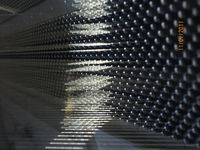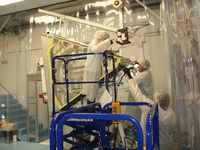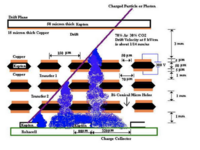Difference between revisions of "TF ResearchInterests"
| (4 intermediate revisions by the same user not shown) | |||
| Line 1: | Line 1: | ||
=Research Interests= | =Research Interests= | ||
| − | My research pursues understanding the structure of a nucleon, a proton or neutron, using polarized electron probes. My work is based at the Thomas Jefferson National Accelerator Facility (JLab), a Department of Energy lab located in Newport News, Va. Specifically, I am currently involved in measuring the ratio of polarized to unpolarized quarks in the nucleon as a means to discriminate between models of the nucleon and a calculation from perturbative Quantum Chromodynamics. | + | My research pursues understanding the structure of a nucleon, a proton or neutron, using polarized electron probes. My work is based at the Thomas Jefferson National Accelerator Facility (JLab), a Department of Energy lab located in Newport News, Va. Specifically, I am currently involved in measuring the ratio of polarized to unpolarized quarks in the nucleon as a means to discriminate between models of the nucleon and a calculation from perturbative Quantum Chromodynamics. A key ingredient to the pursuit of the above measurements involves the design, construction, and testing of detectors used in nuclear physics experiment. My students will be exposed to the art of experimental measurement as well as perform the measurements listed above. |
[[File:TF_FlavorTagging_Borrowed.png | 200 px]] | [[File:TF_FlavorTagging_Borrowed.png | 200 px]] | ||
| − | |||
= Projects= | = Projects= | ||
==CLAS 12 R1 Construction== | ==CLAS 12 R1 Construction== | ||
| − | [[File:B11012011_CLAS12R1C1_Wires.jpg]] | + | [[File:B11012011_CLAS12R1C1_Wires.jpg | 200 px ]] |
| − | [[File:092711_2CLAS12R1StringingBegins.jpg]] | + | [[File:092711_2CLAS12R1StringingBegins.jpg| 200 px]] |
| − | The Idaho Accelerator Center and ISU's Department of Physics are building detectors for an upgrade of Jefferson Lab's Hall B. The detectors are wire chambers containing approximately 5,000, 30 micron diameter wires that are used to form | + | The Idaho Accelerator Center and ISU's Department of Physics are building detectors for an upgrade of Jefferson Lab's Hall B. The detectors are wire chambers containing approximately 5,000, 30 micron diameter wires that are used to form gaseous cells which can detect the passage of ionizing particles. The 2 year long project will construct detectors that are about 6 feet high and will eventually be installed at Jefferson Lab in Newport News, Va. The detectors will be part of a larger detector that will be used by a group of more than 100 physicists to perform fundamental nuclear physics measurements. |
==GEM detectors== | ==GEM detectors== | ||
[[File:TF_GEMdetectorBasicDesign.png | 200 px]] | [[File:TF_GEMdetectorBasicDesign.png | 200 px]] | ||
| + | |||
| + | |||
| + | =Colloquia= | ||
| + | |||
| + | ==1/9/2012== | ||
| + | |||
| + | [[TF_01092012_Colloq]] | ||
| + | |||
| + | |||
| + | ==11/3/2014 == | ||
| + | |||
| + | [[ISU_Coloq_11-3-2014]] | ||
Latest revision as of 18:10, 11 October 2014
Research Interests
My research pursues understanding the structure of a nucleon, a proton or neutron, using polarized electron probes. My work is based at the Thomas Jefferson National Accelerator Facility (JLab), a Department of Energy lab located in Newport News, Va. Specifically, I am currently involved in measuring the ratio of polarized to unpolarized quarks in the nucleon as a means to discriminate between models of the nucleon and a calculation from perturbative Quantum Chromodynamics. A key ingredient to the pursuit of the above measurements involves the design, construction, and testing of detectors used in nuclear physics experiment. My students will be exposed to the art of experimental measurement as well as perform the measurements listed above.
Projects
CLAS 12 R1 Construction
The Idaho Accelerator Center and ISU's Department of Physics are building detectors for an upgrade of Jefferson Lab's Hall B. The detectors are wire chambers containing approximately 5,000, 30 micron diameter wires that are used to form gaseous cells which can detect the passage of ionizing particles. The 2 year long project will construct detectors that are about 6 feet high and will eventually be installed at Jefferson Lab in Newport News, Va. The detectors will be part of a larger detector that will be used by a group of more than 100 physicists to perform fundamental nuclear physics measurements.
GEM detectors
Colloquia
1/9/2012



